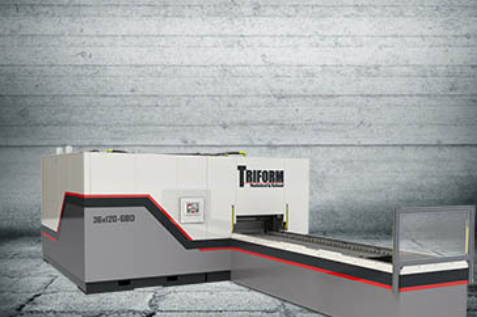What is Sheet Hydroforming?
Sheet Hydroforming is a metal forming process that uses pressurized hydraulic fluid in a flexible diaphragm to shape sheet metal against a single, un-mated tool. The process can create a wide range of complex geometric shapes from a variety of materials including aluminum, steel, stainless, titanium, niobium, Inconel, copper, composites, and more. Sheet hydroforming presses can combine or even replace different metal forming processes including spinning, press brake forming, traditional draw forming, rubber pad forming, progressive die forming, and more. These machines can also consolidate multiple steps into a single cycle, virtually eliminating secondary finishing processes such as polishing, annealing, or welding.

The two primary types of TRIFORM sheet hydroforming presses are fluid cell and deep draw. Fluid cell presses create shallow parts with open corners while deep draw presses are used for taller parts with closed corners and parts up to 15-inches tall.
Types of Sheet Hydroforming
TRIFORM Sheet Hydroforming Uses
Advantages of A TRIFORM Sheet Hydroforming Press
Sheet hydroforming offers many advantages over traditional metal forming processes. Whether you’re using a press brake requiring multiple sets of matched tooling and a skilled operator, deep drawing parts that require finishing work due to marring from the expensive matched tooling, or currently using a process that requires finishing work like welding or annealing, sheet hydroforming can dramatically reduce your expense and improve your production.
Lower Costs
- Tooling – Since the flexible rubber diaphragm acts as a universal female die, mated tooling is not required. This can reduce tooling costs by 50% to 90% compared to conventional forming methods! Additionally, hydroform tools can be made from a variety of materials including steel, aluminum, 3D printed substrates, poured epoxies, and even wood and typically last longer than conventional press tooling due to the uniform pressure applied during the process. Using simulation software like PAM-STAMP by ESI, tooling lead times are greatly reduced.
- Materials – A TRIFORM sheet hydroforming press results in less than 10% variation in blank to finished part thickness, due to uniform elongation of the metal. The applied force during the cycle is multi-directional, drawing the metal around the tool, which greatly reduces stretching or thinning of the formed areas. This allows the starting material thickness to be reduced, greatly reducing upfront costs. A wide range of material can be formed with a TRIFORM sheet hydroforming press, each with varying degrees of thickness including: high-strength alloys, carbon steel, aluminum, stainless steel, composites, copper, and brass.
- Finishing – The flexible diaphragm of the TRIFORM sheet hydroforming press applies even force over every square inch of the part’s surface, resulting in parts with a smooth, uniform, scratch-free surface that require no additional finishing. By eliminating the need for secondary buffing, polishing and other hand work – caused by the marring and scuff marks left by traditional mated dies – labor costs can be significantly reduced. Many parts can even be painted prior to forming, without damage to the surface finish.
- Development – Tooling and material changes are simple and inexpensive with a sheet hydroforming press, giving you the ability to eliminate multi-step processes, reduce tryout costs, and realize more process efficiency. Compare this to the high tooling costs and precision alignment requirements of traditional deep draw systems, where even minor changes to prototype production are very costly and time consuming. Additionally, with a TRIFORM sheet hydroforming press, our sophisticated yet easy-to-use controls minimize the part development process, greatly reducing scrap.
Improved Efficiency & Part Quality
- Quick die setup and changeover – The use of un-mated tooling allows for faster setup and change-over, particularly within the fluid cell process. Triform presses frequently reduce tool change time by 60-70%, making the process ideal for low-volume / high-mix environments. Additionally, tray-style models can form multiple parts in a single cycle and facilitate continuous production via a dual shuttle system.
- Form complex geometric shapes quickly – By consolidating multiple processes into one machine and eliminating secondary finishing, production becomes much more efficient. Parts requiring multiple operations on conventional presses – including complex deep drawn parts – can typically be achieved by a TRIFORM sheet hydroforming press in just one cycle.
- Consistent quality – Using the powerful, intuitive controls system, virtually anyone can form high-quality parts on a TRIFORM sheet hydroforming press, greatly reducing reliance on skilled labor. Tears and wrinkles are no longer an issue because diaphragm pressure and punch position are tightly controlled via the user-friendly interface, and proven part recipes can be saved for later recall. By producing an accurate, repeatable process, Triform has taken sheet hydroforming from an artform to a science.
- Reduced work-hardening – Material tensile strength is maintained for a longer period of time on a TRIFORM sheet hydroforming press compared to conventional drawing applications.






